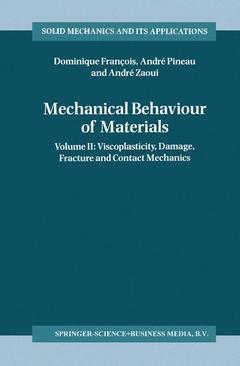Description
Mechanical Behaviour of Materials, 1998
Volume II: Viscoplasticity, Damage, Fracture and Contact Mechanics
Solid Mechanics and Its Applications Series, Vol. 58
Authors: François Dominique, Pineau André, Zaoui André
Language: English
Keywords
Metall; elasticity; fatigue; fracture mechanics; polymer; polymers; viscoelasticity
105.49 €
In Print (Delivery period: 15 days).
Add to cart410 p. · 16x24 cm · Paperback
Description
/li>Contents
/li>Comment
/li>
Foreword.- 1. Various types of damage.- 2. Fracture mechanics.- 3. Brittle fracture.- 4. Ductile fracture.- 5. Ductile-brittle transition.- 6. Fatigue.- 7. Environment assited cracking.- 8. Creep-fatigue-oxidation interactions.- 9. Contact mechanics - friction and wear.- 10. Damage and fracture on non-metallic materials.- Appendix A Diffusion coefficients.




